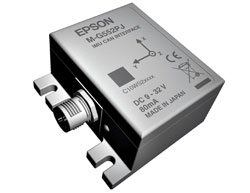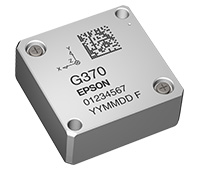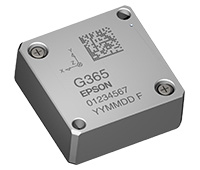Epson IMU ROS2 Driver Node



Contents
Overview
The Epson IMU ROS software is ROS2 C++ wrapper of a Linux C driver for communicating on a ROS2 system
The original Linux C driver can be found at github
- This driver software supports either UART or SPI interface connection to the Epson device
The user should be familiar with building ROS2 packages using the colcon build process
This is NOT detailed step by step instructions
Refer to the README.md inside the ROS package or Github repository for more detailed up-to-date info
Interface Connections
UART Connection & Configuration
- For direct connection, the target UART port on the host must be compatible with CMOS 3.3V I/O
Connection is also possible through a USB-UART 3.3V converter IC such as on the M-G32EV041 evaluation board
- Connecting GPIO output for asserting RESET# pin on the Epson device is optional, but recommended where possible (i.e. on embedded platforms)
- Below is an example UART connection when using a Raspberry Pi based system:
Epson IMU
Raspberry Pi
EPSON_SIN Input
RPI_GPIO_P1_8 (GPIO14/UART_TXD) Output
EPSON_SOUT Output
RPI_GPIO_P1_10 (GPIO15/UART_RXD) Input
EPSON_RESET Input
RPI_GPIO_P1_15 (GPIO22) Output *Optional, but recommended*
- When connecting the Epson G552PRx to a ROS system, the underlying UART connection must be compatible with RS422 I/O signal levels
- Below is an example RS422 connection to a RS422 Host:
Epson IMU
RS422 Host
EPSON_TD+ Output
HOST_RD+ Input
EPSON_TD- Output
HOST_RD- Input
EPSON_RD+ Input
HOST_TD+ Output
EPSON_RD- Input
HOST_TD- Output
SPI Connection & Configuration
- Interfacing the Epson device using SPI is typically applicable only to embedded Linux platforms
- Direct connection to SPI port must be compatible with CMOS 3.3V I/O
Connection between the host & Epson device is possible using the M-G32EV031 evaluation breakout board
This driver uses the [https://github.com/WiringPi/WiringPi/ |Unofficial wiringPi library]] to generate low level SPI communication & accurate time delays
- Other libraries can be used to generate timer delays and SPI messages but requires changes to redirect the low-level function calls
Accurate timing delays are necessary to ensure throughput for high imu_dout_rate (refer to IMU datasheets for timing specifications)
- Below is an example SPI connection when using a Raspberry Pi:
Epson IMU
Raspberry Pi
EPSON_RESET Input
RPI_GPIO_P1_15 (GPIO22) Output
EPSON_DRDY Output
RPI_GPIO_P1_18 (GPIO24) Input
EPSON_CS Input
RPI_GPIO_P1_16 (GPIO23) Output
EPSON_SCLK Input
RPI_GPIO_P1_23 (GPIO11) Output
EPSON_DOUT Output
RPI_GPIO_P1_19 (GPIO10) Input
EPSON_DIN Input
RPI_GPIO_P1_21 (GPIO9) Output
SPI Configuration for Timer Delays
This software contains wrapper functions for time delays in millisecond and microseconds using seDelayMS() and seDelayMicroSecs(), respectively.
- On embedded Linux platforms, these function calls are redirected to platform-specific HW delay routines
For example on RaspberryPi, the time delay functions for millisecond and microseconds is redirected to WiringPi library delay() and delayMicroseconds()
- If a hardware delay is not available from a library, then a custom software delay loop is an option (but not preferred)
SPI Configuration for GPIO Control
- This software uses the following 3 GPIO pins on the host for connection to the Epson device
GPIO output for asserting CS# on the Epson device (NOTE: Alternatively, pin SPI0_CE0 on the RaspberryPi can be used)
GPIO input for reading the logic status on the Epson device DRDY (GPIO1) pin
GPIO output for asserting RESET# on the Epson device
Connecting CS# and DRDY to the Epson device is mandatory
RESET# is recommended for asserting Hardware Reset during every initialization for better robustness
ROS2 Node
This ROS2 driver publishes IMU messages as per REP 145 Conventions for IMU Sensor Drivers
Imu Message - contains header, orientation, angular velocity and linear acceleration
Temperature Message - contains header, temperature in Degrees Celsius
Orientation Data
For models that support quaternion output, Imu Message publish on imu/data, and the orientation field can update with valid data
For models that do not support quaternion output, Imu Message publish on imu/data_raw, and the orientation field will not update with valid data
Launch File
The python launch files in the launch folder is used to pass the initialization parameters to configure the Epson device at runtime using ros2 launch
Initialization parameter changes by editing the launch file does not require rebuilding with colcon
The user needs to modify imu_dout_rate & imu_filter_sel as needed based on user requirements
Timestamping With EXT Signal (Time Correction)
- The Epson device has a 3.3V I/O EXT (GPIO2) pin which can be connected to a cyclic external sync signal such as a GNSS 1PPS signal
When time_correction_en is enabled (set to true), the driver attempts to correct the time stamp field in Imu Message using the devices internal reset counter value (measured time delay since latest GNSS 1PPS)
DeclareLaunchArgument( name="time_correction_en", default_value="false", description="Enables using IMU external counter reset function for timestamp with external 1PPS connected to IMU input pin for GPIO2/EXT", ),The use of time_correction_en is intended to give a more accurate timestamp of the inertial data by minimizing the effects of link and host processing delays
Building & Installing ROS2 Node
Place this package (including folders) into a new folder within your colcon workspace src/ folder.
Modify the CMakeLists.txt to:
Select the PLATFORM to NONE for PC or RPI for RaspberryPi depending on your host platform
Select the INTERFACE to UART or SPI depending on the serial connection
NOTE: You *MUST* re-build using catkin_make when changing the PLATFORM or INTERFACE or making any changes in the CMakeLists.txt
From the colcon workspace folder run colcon build to build all changed ROS2 packages located in the <colcon_workspace>/src/ folder
- Reload the current ROS2 environment variables that may have changed after the colcon build process.
From the <colcon_workspace>/source install/setup.bash
Modify the appropriate launch file in the launch folder to set your desired initialization parameters
Typically, only the imu_dout_rate & imu_filter_sel needs to be edited
Running the ROS2 Node
To start the Epson IMU ROS2 driver use the appropriate launch file located in launch/ with ros2 launch
- For example:
<colcon_workspace>/ros2 launch ess_imu_driver2 launch.py
USB-UART Latency
When using USB-UART bridge ICs to connect between the Linux host & Epson device, higher than expected latencies or slower than expected data rates are possible
For example, the M-G32EV041 evaluation board uses an FTDI IC and driver
If the connection between the Epson device UART and Linux host is by FTDI, the latency_timer setting in the FTDI Linux driver may be large i.e. typically 16 (msec)
There are 3 methods listed below to reduce the impact of this latency by setting the latency_timer to 1msec
Modifying *latency_timer* by *udev* mechanism
udev is a device manager for Linux that can dynamically create and remove devices in *userspace* and run commands when new devices appear
Create a *udev* rule to automatically set the latency_timer to 1 when an FTDI USB-UART device is plugged in
- For example, below is a text file named *99-ftdi_sio.rules* that can be put in the */etc/udev/rules.d* directory
SUBSYSTEM=="usb-serial", DRIVER=="ftdi_sio", ATTR{latency_timer}="1"NOTE: Root (sudo) access is required to create or copy file in */etc/udev/rules.d* NOTE: This is the preferred method because it automatically triggers when the device is plugged in. However, it affects ALL FTDI USB-UART devices on the host system
Modifying *latency_timer* by *sysfs* mechanism
- The example below reads the *latency_timer* setting for */dev/ttyUSB0* which returns 16msec.
- Then, it sets the *latency_timer* to 1msec, and confirms it by readback.
NOTE: May require root (sudo su) access on your system
cat /sys/bus/usb-serial/devices/ttyUSB0/latency_timer 16 echo 1 > /sys/bus/usb-serial/devices/ttyUSB0/latency_timer cat /sys/bus/usb-serial/devices/ttyUSB0/latency_timer 1
Modifying *low_latency* flag using *setserial* utility
The example below sets the low_latency flag for /dev/ttyUSB0
This will have the same effect as setting the latency_timer to 1msec.
This can be confirmed by running the setserial command again.
NOTE: You may need to install setserial with sudo apt install setserial
user@user:~$ setserial /dev/ttyUSB0 /dev/ttyUSB0, UART: unknown, Port: 0x0000, IRQ: 0 user@user:~$ setserial /dev/ttyUSB0 low_latency user@user:~$ setserial /dev/ttyUSB0 /dev/ttyUSB0, UART: unknown, Port: 0x0000, IRQ: 0, Flags: low_latency
Technical Support
For technical support or related issues using this ROS software, please email sensingsystem_support@ea.epson.com
